9-mm pistol Walther R.38 (Walter P.38) (PPK)
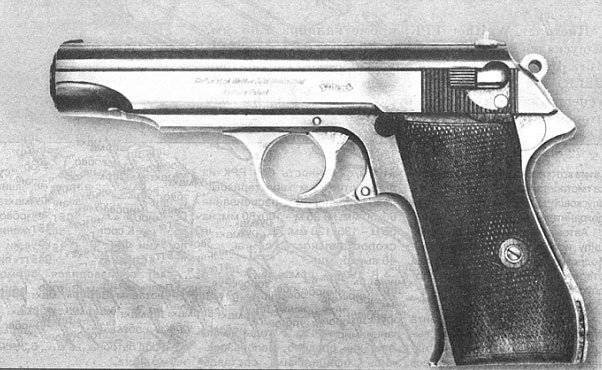
History The Walther P.38 pistol began with the first model 9-mm Walther MP. This gun still doesn’t look through the P.38, it is very similar to the increased Walther PP.
To the secret work on the design of office (as they tried to disguise this new weapon) guns of a new generation, destined for the rearmament of the Reichswehr, the German arms firms again started at the end of 1929. Engineers from Carl Walther Waffefabrik GmbH tried to develop their initial success, based on the successful design of the PP pistol. Its enlarged version, called the Walther MP (Militarpistote. German. - military pistol), was designed for the use of cartridges 9x19 mm Parabellum. Pistols Walther MP of the first and second models differed slightly among themselves, only in individual details. Automation pistols also worked on the principle of recoil free shutter with a fixed barrel. However, the results of factory tests of both models of the Walther MP pistol have convincingly demonstrated that the use of a powerful 9-mm cartridge is impossible in weapon systems with an uncoupled shutter.
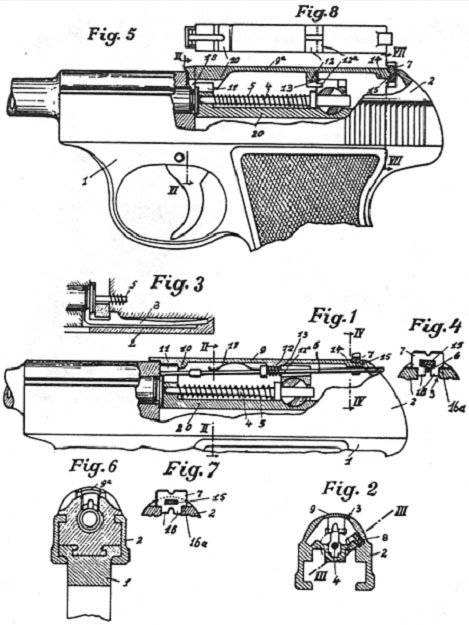
The lack of funding for some time forced the German designers to postpone this work. And only the coming of the Nazis to power in 1933, with their course to prepare for a new war, contributed to the beginning of work on the creation of more advanced models of military equipment and weapons, including small arms. However, outdated technologies and significant amounts of mechanical work on manual refinement not only influenced the high cost of manufacturing certain products, but excluded the possibility of a quick rearmament of the Wehrmacht. In particular, this also applied to the regular army 9-mm pistol R.08. Therefore, by the mid-thirties in Germany, the question of finding a worthy replacement for the old Parabellum pistol was very acute. German gunsmith designers began to design a qualitatively new model of a military pistol, using all their design capabilities, not only technical, but also technological, they had developed during the creation of previous models of short-barreled self-defense weapons.
Already in 1934 - 35. Carl Walther Waffenlabnk GmbH has transferred to HWaA a new model of a military-style pistol known under the same name Walther MP. Like the previous versions of the MP, it was designed to use the Parabellum 9-mm pistol cartridge. Despite the fact that outwardly it was a completely different pistol, the ideas incorporated in the first samples of Walther PP and MP pistols were developed in its design: the automatics of the third model of the MP pistol also worked on the principle of using recoil of a free shutter, self-reset trigger mechanism. Especially for this gun George and Erich Walter have developed new components and parts. Including: shortened cover-casing, extractor, drummer, cartridge presence indicator in the chamber, patented by 10.04.1936 in Germany (DRP patent No. 706038). A special feature of this model was the original trigger trigger with a hidden trigger position. However, after numerous factory and field tests, many design flaws of this model emerged, therefore, work on it was discontinued. This sample MP pistol has remained exclusively in experienced models.
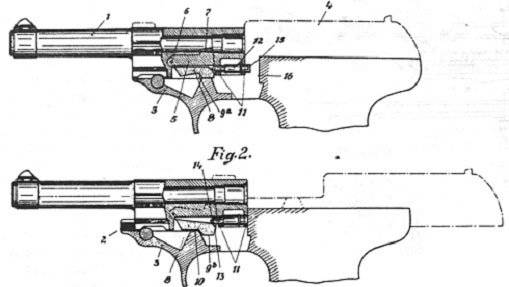
New failure did not dampen the research fervor of the German gunsmiths. Already in October of the same year, one of the co-owners of the company Carl Walther Waffenfabrik GmbH, the youngest of the dynasty, Fritz Walter and engineer Fritz Barthlemens (Barthlemens) received a patent (DRP No. 721702 from 27.10.1936) for a locking system of the barrel bore - a latch rotating in a vertical plane . It was this decision that formed the basis of the new generation of German military pistols Walther. Soon the firm Walther. so as not to confuse newly created weapons with previous models of MP. assigned the new pistols the name Walther AR (Armeepistole, German - army pistol).
The modified Walther AP was a completely different design. Automation worked on the principle of recoil with a short stroke of the barrel, the barrel was locked with a swinging latch. The trigger mechanism was borrowed from the previous MP model - self-cocking, hammer type with a hidden trigger position. The barrel and housing-slide under the action of recoil moved along the outer guides of the frame, and in the front part of the housing-bolt a large cut-out appeared, opening almost the entire breech block. Flap fuse mounted on the left side of the housing-bolt. Two return springs were located on both sides of the pistol frame.
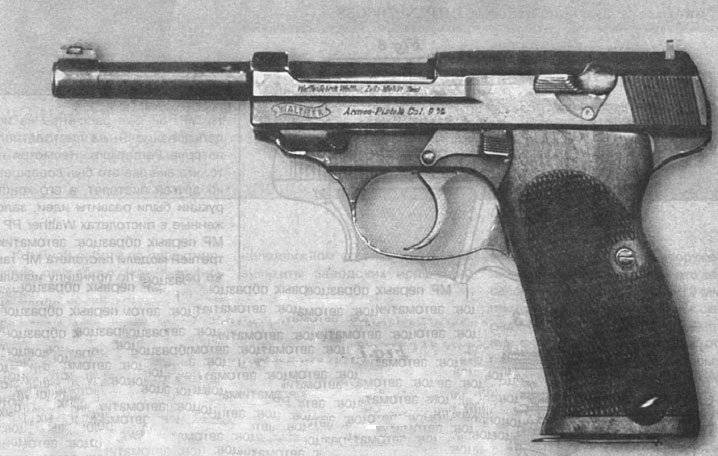
Already in the spring of 1937, the company Sam Walther Wafflenfabrik GmbH presented the AP pistols for testing at the site in Qom merce dor-fv 200. And again suffered a fiasco. Representatives of HwaA noted the numerous design flaws of Walther AR. First of all, it concerned the internal location of the trigger, which was unsafe because it did not visually determine whether the weapon was loaded. According to the military, Walther AR was also inherent in the high labor intensity of manufacturing and high cost.
All this prompted the Wehrmacht to abandon the gun, although the promise of the design itself was obvious.
Despite the failure, in the same year, the company Walther proactively developed another modification, known as the fourth model MP. Alterations touched mainly the design of the firing mechanism and details of the housing-bolt model AR. The trigger was made safer to handle — externally; now it can be controlled visually and at night - by touch.
In order not to cause confusion in the factory technical documentation, the latest model of the MP pistol is soon assigned a new designation - HP (it. - Heeres-Pistole - a gun for the armed forces, a military pistol). An index of the presence of a cartridge in the chamber, as in Walther PP, was introduced into its construction.
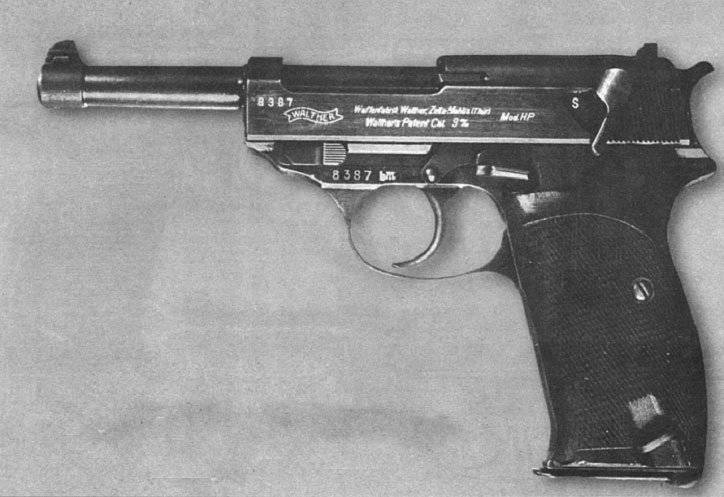
The new Walther HP model, presented for final competitive testing in 1938, defeated competing short-barreled weapons: Mauser-Werke AG, Sauer & Sohn and Berlin-Suler Waffenfabrik. After the modification of the fuse mechanism of the 9-mm Walther HP, which without any reservations can be attributed to one of the most successful technical designs of weapons of that time, was adopted by the Wehrmacht as a standard service pistol called P.38 (German - Pistole 38, pistol sample 38 (1938)). Its main difference from Walther HP was the simplified safety mechanism.
The pistol had two fuses — a manual flag, which was located outside on the left side of the shutter-casing, and an automatic internal one. The first did not allow accidental shots, the second - premature, when the shutter is not completely locked the barrel. When the manual safety switch was turned on, the drummer was blocked and the trigger could not be put on a combat platoon. The action of the automatic fuse was also associated with the work of the drummer, who was released from blocking only when the bolt arrived in the forward position. Compared to the Walther prototype, the P.38 also had a wider ejector that improved its performance in difficult working conditions; simplified in the manufacture of a round drummer, instead of a rectangular one in HP; stamped shutter lag instead of milled.
Walther R.38 pistol consisted of 58 main parts, assemblies and mechanisms: barrel; pistol frame; shutter; the locking latch; trigger mechanism; shop; safety devices and sighting devices.
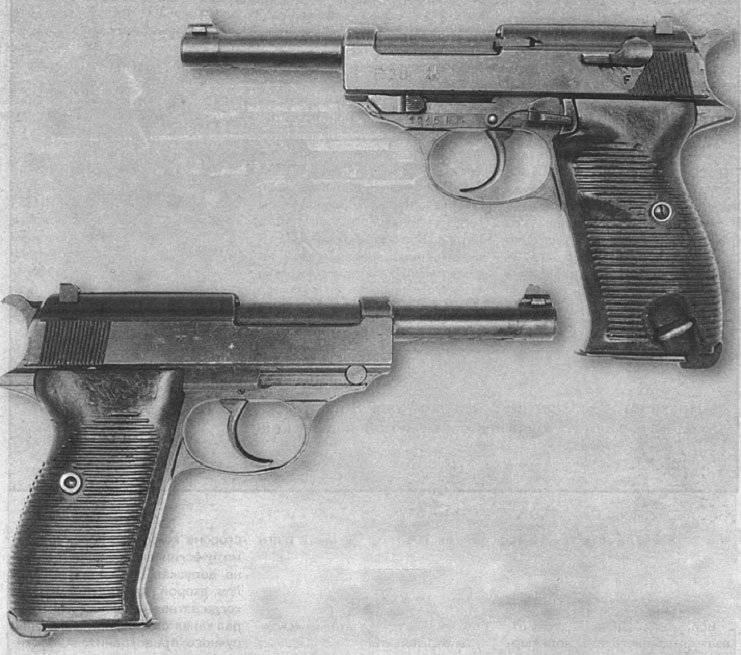
Automation Walther R.38 worked on the principle of using recoil in the short course of the barrel. The barrel bore was locked by a shutter casing using a latch rotating in a vertical plane. The percussion mechanism is of a hammer type with an open trigger position; the combat spring was mounted in the handle. The special features of the pistol R.38 include a self-retarding trigger mechanism, which significantly increased the pistol’s combat readiness in terms of carrying it with a cartridge in the chamber, because, along with the reduction in time for the first shot, it allowed the striker to re-strike the cartridge in the case of his misfires.
It should be noted that the self-platoon also caused certain difficulties in the use of a pistol. since this inevitably led to a sharp (approximately threefold) increase in the effort of descent. The need to compress a strong combat spring led (even for well-trained shooters) to a significant deterioration in the accuracy of the pistol fight. -Javeling weapons when shooting from poorly trained shooters led to a loss of accuracy. When the cartridges were used up, the shutter stopped at the slide delay in the rear position. On the P.38, as on other Walther pistols. the indicator of the presence of the cartridge in the chamber was mounted, which allowed not only visually but also to touch, in the dark, to determine whether the weapon was loaded. The gun had a constant sight, designed for a firing range of up to 50 m. Magazine capacity - 8 cartridges.
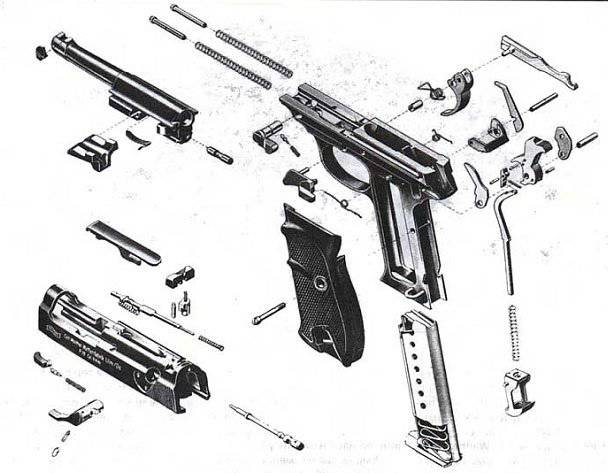
The Wehrmacht issued to the Thuringian firm a colossal order for Walther R.410000 38 pistols. Already at the end of 1939, Carl Walther Wattenlabrik GmbH started its implementation, however, only 26 on April 1940 was their first batch in 1500 units. left the assembly shops of the company. By the summer of 1940, 13000 pistols of Walther R.38 zero-series pistols were launched, which were originally intended only for ground forces. 38 R.1940 Pistols 41-XNUMX Release. had a blued surface, in addition, on the weapons of the zero series were mounted the same wooden cheeks with a small diamond-shaped notch, like HP.
The P.38 pistol that replaced the Parabellum, being much simpler in production, accordingly required much less material- and labor costs for its manufacture. The production of one P.38 required 4.4 kg of metal, with the mass of the gun itself 0,94 kg and 13 people / h. The new gun was in production cheaper than the P.08. So. in January 1945, its cost at Mauser-Werke was 31 brand, while Parabellum two years earlier managed the same company in 35 brands.
Initially, Walther R.38 pistols were armed by officers of the ground forces, the first settlement numbers of heavy weapons, and also part of the noncommissioned officers of the Wehrmacht and the SS field forces. Already the first battles of the Second World War fully revealed the high efficiency, ease of handling and reliability in the use of these pistols. Deployment of large-scale hostilities on the Eastern Front in 1941-42 led to significant losses Wehrmacht short arms. The repeated increase in the needs of the German army in personal defense weapons required a sharp increase in the production of regular R.XNXX pistols.
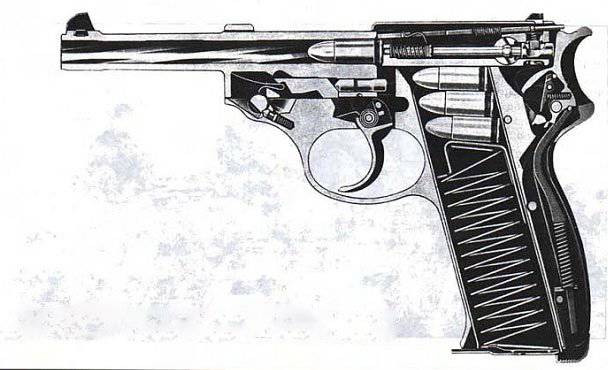
The small capacity of the company Walther (in 1939, its entire staff consisted of only 500 people) was the main reason for the unprecedented act in modern German history - the transfer of licenses and technical documentation for the production of a pistol to competing companies: the Auburn-Dorfsky Mauser-Werke AG. 1942, which began manufacturing the gun in September, and Spree-Werke GmbH, since May 1943, which organized with the help of engineers with Mauser-Werke the release of the R.38 at their enterprises in Spandau (Germany) and the Czech city of Gradkov nad Nisou .
The expansion of the production of Walther R.38 pistols required an increasing release of spare and component parts. Therefore, a number of Western European arms factories operating under the full control of the Germans were involved in the cooperation in their production. So. The Czech arms concern in Prague, Bohmische Waffenfabrlk AG (formerly Ceska Zbrojovka), manufactured trunks for the firms Carl Walther Waffenfabrlk GmbH and Spree-Werke GmbH. The largest arms concerns the Belgian Fabrique Nationale d'Armes de Guerre in Gerstal and the Czech Zbrojovka Brno in Brno produced the frames and closures-closures R.38. Another Czech factory Erste Not dbohmische Waffenfabrik and one of the oldest German arms companies CG Haenel Waffen - und Fahrradfabnk AG specialized in the manufacture of shops. All these measures allowed a sharp increase in the release of personal self-defense weapons, so necessary to the front.
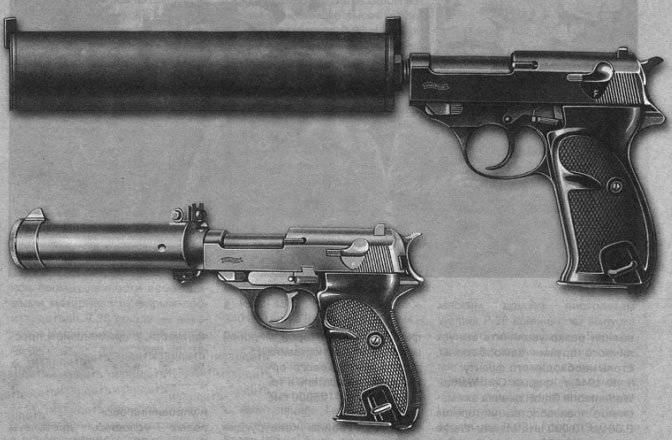
By 1944, the company Carl Walther Waffenfabrik GmbH brought the monthly production of R. 38 pistols to 10 Ltd., Mauser-Werke AG - to 12 500, but all were overtaken by Spree-Werke, one of the few German arms firms of the Second World War period, which put the production of small arms on stream. Its record in the same year is a record one - 25000 pistols P.38 per month.
During the war, the design of P.38 did not undergo any special changes, although gunsmiths continued research related, in particular, to the use of press-stamping equipment for the manufacture of frame and casing-bolt from steel sheet. To reduce the cost of production and simplify maintenance in the field, Walther R.38 pistols have got the cheeks of a new design - with transverse wide grooves, which were made from a special sort of plastic - brown bakelite. However, depending on the company-postav-chic and time of manufacture, they turned out a variety of shades, up to black. A further reduction in military acceptance requirements for the exterior decoration of weapons led to the fact that in 1942-45. Walther pistols to reduce their cost after final machining began to apply a cheaper semi-matt coating on metal parts. And only at the very end of the war, in connection with the general deterioration in the supply of the weapons industry with the necessary materials, the manufacturing companies R.38 went for some deterioration in the external finish of the pistol, which, however, did not affect the reduction in the combat qualities of the weapon.
On the fronts of the Second World War, R. 38 was distinguished by its ease of operation and unpretentious maintenance, as well as good combat accuracy. He is not inferior in this indicator to the legendary Parabellum. When firing at 25 m, a bullet fired from a P.38 pistol at an initial speed of 355 m / s punched a pine board with a thickness of 23, see. An iron sheet 2 mm thick with a bullet hit at an angle of 90 degrees was pierced from the distance to 20 m. At the same time, steel sheet 2 mm thick and iron sheet 3 mm thick from the 25 distance m did not penetrate, but received only a strong dent. However, this was quite enough to fight the enemy's manpower at a distance of 25 - 50 m.
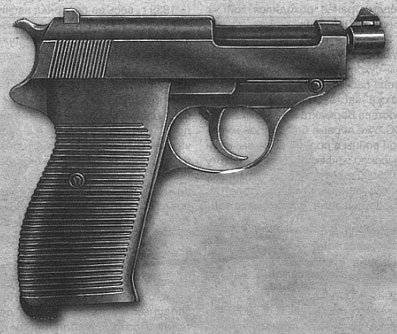
Along with the Wehrmacht, a small number of P. 38 and their modifications were also used in the security service - the SD. Only for the Third Reich Interior Ministry during the war years was 11 150 pistols manufactured by Walter HP. In 1944, on the special request of the General Directorate of Imperial Security (PCHA) for the needs of geociano and SD, Spree-Werke GmbH manufactured several thousand R.38 shortened pistols with a barrel length of just 70 mm. A year earlier, according to unconfirmed reports, German arms firms produced a batch of 1500 pcs. R.38. designed under the patron of the 7,65x22 Parabellum, which was done explicitly for commercial purposes for sale in the Latin American arms market.
In total, during the war years, the German military industry supplied the armed forces and special services of the Third Reich 1 180 Ltd. R. 38 pistols. And in 1939- 45. firm Carl Walther Waffenafbrik GmbH has released 555 000 pcs. Walther P.38, Mauser-Werke AG in 1942-45 respectively -340 000 pcs., a Spree-Werke GmbH-from the end of 1943 to 1945. - 285 000 pcs.
The defeat of the Third Reich completed another, but by no means the last page in the history of the unique Walther R.38 pistol. With the capitulation of Germany, the military manufactures of the firms Walther and Spree-Werke were eliminated, and their equipment was exported to reparations to the USSR, Poland, Czechoslovakia and Yugoslavia.
Only Mauser-Werke continued to release R. 38 after the war. 20 April 1945. French troops occupied the city of Oberndorf-on-Neckar, where the main facilities of this company were located. And soon the production of R.38 was resumed here, but already for the French occupation forces. Subsequently, this weapon was used for several decades by both the armed forces and the special services of France, which, by the way, was the cause of one of the many conflicts between East and West. And only in the summer of 1946, as a result of repeated protests by the Soviet side, the equipment of Mauser-Werke AG was also able to be taken out for reparations, and the production complex itself was blown up so that the Germans would not start producing weapons here again. However, this did not prevent many other Walther R.38 pistols from the war years of release from obtaining a second life after the defeat of the Wehrmacht. So, R. 36 pistols made in 1940-45. Armed armies and law enforcement agencies of many states. Along with the Bundeswehr, where P 38 since the end of 1940's. again became a regular army pistol, they, up to the middle of the 1950-ies .. were used and the barracks police of the GDR. In addition, 1945-46's. At the former Spree-Werke company in the Czech town of Hradkov-nad-Nisoy, approximately 3000 38 pistols were assembled from the remaining parts stocks in the warehouses. subsequently transferred to the Czechoslovak People's Army. And today, already 50 years after the end of the war, many R.38 military graduates are in service with armies and law enforcement agencies in Austria, Lebanon, Mozambique, Pakistan ...
Information